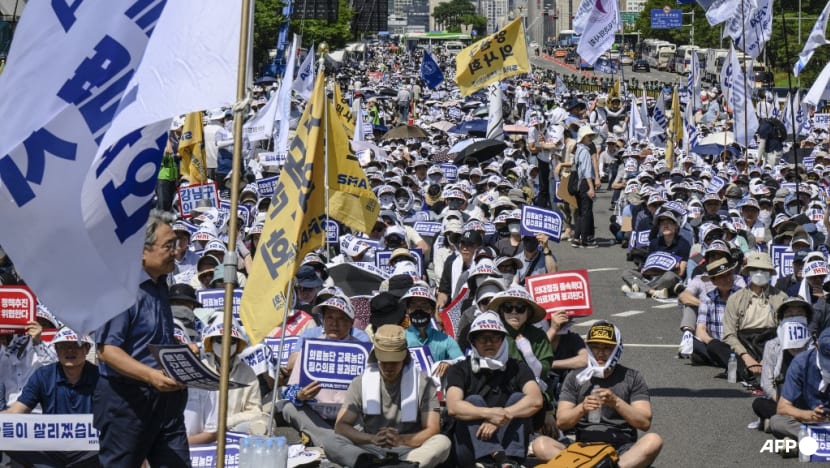Commentary: South Korean doctors’ strike is a medical drama with no heroes
More than 12,000 South Korean doctors have gone on strike in a months-long protest against medical reforms. It may be the wrong position to take, but the government has much to account for too, say Erik Mobrand from Seoul National University and Hyejin Kim from National University of Singapore.

Members of The Korea Medical Association at a protest in Seoul on Jun 18, 2024. Since February, more than 12,000 doctors at over 100 hospitals have walked away from their jobs in protest over a government policy to increase medical school admissions. (Photo: AFP/Anthony Wallace)

This audio is generated by an AI tool.
SEOUL: To see doctors walk off the job is a jarring image. These professionals are, after all, charged with caring for others in society, including treating the sick and wounded. In South Korea, however, this surprising development is precisely what has happened.
Since February, more than 12,000 doctors at over 100 hospitals have walked away from their jobs in protest over a government policy to increase medical school admissions. Medical students, interns and resident doctors were the first to go on strike, with senior doctors and medical professors later joining in solidarity.
This is a fraction of the estimated 140,000 doctors in South Korea, but the strike has resulted in the cancellation of hundreds of surgeries and other treatments.
This situation emerged because South Korea’s healthcare sector - plagued by salary and working condition issues - needs to be reformed but an earlier attempt at compromise and incremental change fell apart.
Since 2016, admissions into South Korea’s medical schools have been capped at 3,058 a year. In 2020, the Moon Jae-in government proposed raising this by a moderate 400 places a year to address a shortage of physicians. Doctors vehemently opposed the proposal and went on strike, fearing they would have to share more of the medical sector revenue.
Their actions unfolded against the backdrop of the COVID-19 pandemic. Because of the urgent need for medical care, the government surrendered. Doctors returned to work having “won” after a month-long strike and prevented an increase in the supply of physicians.
This time around, President Yoon Suk Yeol’s administration initially proposed raising the annual medical school enrolment quota by 2,000. Once again, doctors have responded with anger and indignation. This reaction is not surprising. If they had rejected an increase of 400 in 2020, they would surely reject 2,000.
SOUTH KOREA’S HEALTHCARE ISSUES
The South Korean medical system has excellent features. An international healthcare index ranked South Korea’s medical care system second globally in 2024. The country also exports its know-how to other countries, including cooperation in traditional Korean medicine, training programmes and academic exchanges.
Regular public health checks are provided at no cost for citizens and long-term residents. The affordability of visiting the doctor and receiving basic prescription medicines also is a strength of the system.
General medical care in Seoul is highly accessible. However, the population is ageing rapidly, sparking debate over whether the current number of doctors is sufficient. Research by the Korea Institute for Health and Social Affairs suggests that South Korea may need up to 27,000 more doctors by 2035 to meet demand.
One of the main problems is in the distribution of doctors across rural and urban places. In the city, every 1,000 residents has three physicians, while this figure stands at 1.6 in the countryside.
Doctors are reluctant to set up practice in rural areas. A few reasons drive this: In a 2020 Korean Physician Survey, 58 per cent of doctors surveyed cited “children’s education” as their top concern for not wanting to move to a rural location. This was followed closely by “difficulties living away from family”, at 53 per cent.
Another issue is the uneven distribution of physicians across specialisations. Large numbers are pulled into lucrative fields - a problem that is not specific to South Korea. Over the last 10 years, the number of cosmetic surgeons in South Korea has increased by 76 per cent and dermatologists by 39 per cent.
Often called the “plastic surgery capital of the world”, South Korea last year attracted a record 606,000 foreign patients, up from 248,000 the previous year.
Specialisations like obstetrics are less desirable because of the fear of lawsuits. According to the Korean Medical Association, doctors in South Korea face a higher risk of being sued by patients compared with other countries. It estimates that about 750 South Korean doctors annually, or an average of more than two per day - are criminally charged with professional negligence resulting in death or injury.
WHERE DID THE 2,000 FIGURE COME FROM?
The doctors who have gone on strike are clearly in the wrong on the big picture of the country’s public health. There is little public sympathy for them, because people know the country needs more physicians. More than 70 per cent of citizens support increasing the number of places in medical school.
At the same time, perhaps paradoxically, more than 60 per cent of citizens also think the government’s approach is wrong. If doctors have taken the wrong position, it is not because the government has taken the right one. This is an episode with no heroes.
The current proposal for the enrolment quota hike seems arbitrary. No explanation has been offered for how the initial 2,000 figure was reached. Why exactly this number, and how does it link to the problems that have been identified?
The lack of clarity on the logic for such a dramatic and sudden increase has been a source of criticism. This criticism comes not just from the opposition but also from politicians within the president’s own party.
As for the medical profession, one concern is that medical schools do not have the capacity to accommodate a leap of 2,000 more students per year.
Medical schools have agreed now that there can be an increase but they say that 2,000 is too many to train properly. Doing so would require sharing more space, instructors and equipment. As a result, there is a concern that a rapid increase in medical students and then in physicians could lead to a decline in the quality of instruction and therefore a decline in the quality of medical care by new physicians.
On the other hand, the proposal has been warmly welcomed by the private tuition sector. In Seoul, a medical school course for primary school students has already appeared, anticipating a wave of enthusiasm.
Planning for admission enlargement proceeds. The education authorities have committed to raising the entrance quota for the coming year by 1,500.
The most obvious compromise would be for the government to propose an even smaller increase, which would mean returning precisely to where we were in 2020. If that point is reached, then it would underscore the absurdity of the current situation.
Erik Mobrand is Professor of Korean Studies at the Graduate School of International Studies, Seoul National University. Hyejin Kim is Senior Lecturer of political science at the National University of Singapore.





















